
Introduction: Sparks in the Void
Back in the day, creating something complex without backend knowledge and advanced frontend skills was like spitting against the wind for a solo designer — absolutely impossible. But with the arrival of AI, things changed a little. In this case study, I’ll share how ChatGPT and Grok-3 helped me build the bleibtgleich’25 portfolio (which, by the way, I already dislike).
Concept: Born from Disgust
The idea for this portfolio didn’t just fall from the sky. The first version I put together was pathetic, boring, faceless, and nauseatingly weak. I even built it in Webflow over a couple of days and showed it to my colleague Ivan. His voice carried a note of doubt, and I understood everything without him needing to say more. Sure, there were a few minor interesting touches, but it didn’t reflect me at all. His uncertainty stuck in my mind and started growing like bamboo. Each time I opened the project, I hated it more.
Then came the breaking point. I scrapped everything and started from scratch. While scrolling through other portfolios, something struck me: the awful, plastic, lifeless text that kept repeating from one portfolio to the next, sometimes even word for word. The uniformity was so mind-numbing I wanted to gouge my eyes out.
And that’s when it hit me: pain and hatred that’s the truth. Pain from a drained mind, from endless client edits, from the suffocating routine. Hatred towards tools that never work the way you want them to, towards yourself, towards that eternal impostor inside whispering that you’re a fraud. That’s the life of a designer and I decided to capture that mood, the mood of a burnt-out, cynical designer.
Clinging to that thought, I sketched out the first iteration in just an hour and a half — already miles ahead of the garbage I’d made before.
A few versions later, I landed on something that felt right. By the next evening, it was done. Or almost done a few things were still reworked along the way.
Implementation: Code, Inspiration, Chaos
It all started with a silly thought: is it even possible to track other users’ cursors in Webflow? Just for fun, as part of the concept. I began bombarding ChatGPT with questions: how the hell could this be done? And, as it turned out, it was possible.
I assumed the first solution it gave me would be the usual clunky, barely functional, and full of bugs. But damn, when I saw my cursor appear on screen, and then my colleague’s on the first try it was pure ecstasy. I felt such a surge of inspiration that even now, while typing this, a trace of it still lingers. I couldn’t believe that after so many steps, nothing broke and everything just worked right out of the gate.
Fueled by that momentum, I kept going. I started looking at ChatGPT differently and began thinking about what to tackle next. My eyes landed on hover animations like those on Locomotive. I deconstructed one, crafted a clear prompt, and after a couple of iterations, the shuffle effect was smoothly integrated into my site. That got me even more fired up. I remembered I had long wanted to dive into GSAP. (I had even tried learning JavaScript — of course, I didn’t really learn it, but at least I figured out how to read it.) In the end, that wasn’t an issue either — through trial and error, I managed to animate all the site’s text the way I wanted.
I got into the groove. And just for fun, I thought, what if I throw in some WebGL? That’s when ChatGPT started to stumble a bit. I fed it an entire Tympanus repository, and after a couple dozen iterations and tweaks, I finally got the desired effect. That part was probably the most challenging piece of the entire site’s development.
There was one really cool idea that, unfortunately, I had to abandon. Ivan (yes, the same colleague) and I had this plan to create a joint 404 page: take a chunk of his portfolio (which he still hasn’t finished — Ivan, if it’s not done by the time this case goes live, you owe me 1 ETH), link our websites via WebSocket, and draw in a Windows 95-style interface like MS Paint. But burnout hit me hard, and I had to let it go.
The final touch ended up being the project animation I saw on Tympanus once again, the “what if” idea became part of my portfolio.
By that point, I had already built a ton of things, drowned in bugs, tried to refactor the code, but everything kept breaking. Neither Grok-3 nor ChatGPT could pull me out of that hell. Waves of hatred kept crashing down sometimes toward myself, sometimes toward the dev process. Burnout was suffocating me, and I realized: it’s time to stop, before I delete everything for good.
Copywriting: Depression and Aggression
Yes, the text was also written in collaboration with ChatGPT. Every word went through dozens if not hundreds of iterations. I stitched together a Frankenstein of fragments, forcing ChatGPT to rewrite again and again until I squeezed out that exact depressive-aggressive vibe that had been living in my head lately.
Though honestly, living under rockets and Shaheds hitting us every night, that mood has started to feel like the new normal. Even this very case study is being written to the sound of air defense taking down yet another Shahed.
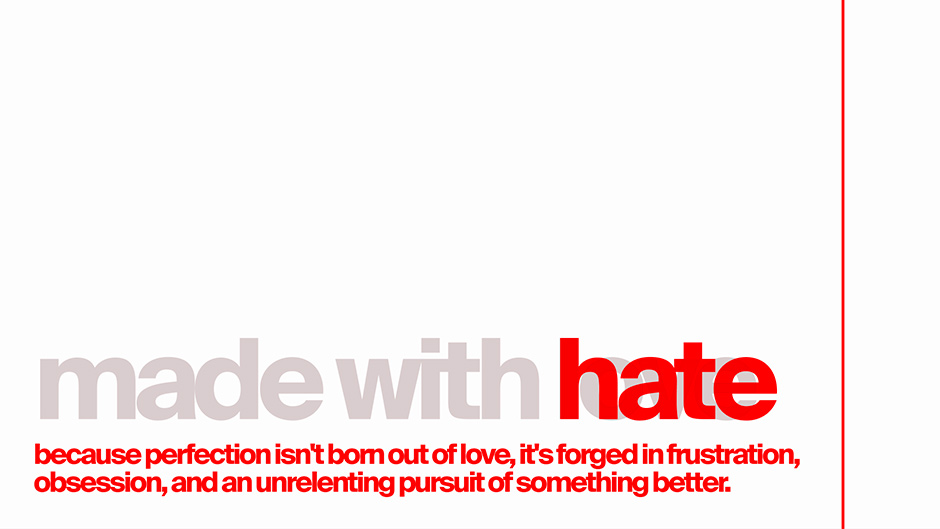
Conclusion
What did I take away from this case? ChatGPT is an incredible tool for the modern designer with ambition. These days, a designer only needs basic JavaScript skills, even just being able to read code and proficiency in Webflow. With that alone, combined with ChatGPT, any of your wildest, most chaotic ideas can come to life just like mine did. And if you go deeper into JavaScript, you can even become a creative developer, something I’m now aiming for.
I’m damn proud that this concept resonated with so many people, and that my work earned every recognition I had set my sights on. I hope this chaotic stream of thoughts inspires someone to try something similar.
Bonus: Details You Might Have Missed in My Portfolio
Dynamic Favicon — the favicon changes dynamically — it’s a blank white square while you're on the site, and switches to my logo with a new page title the moment you navigate away.
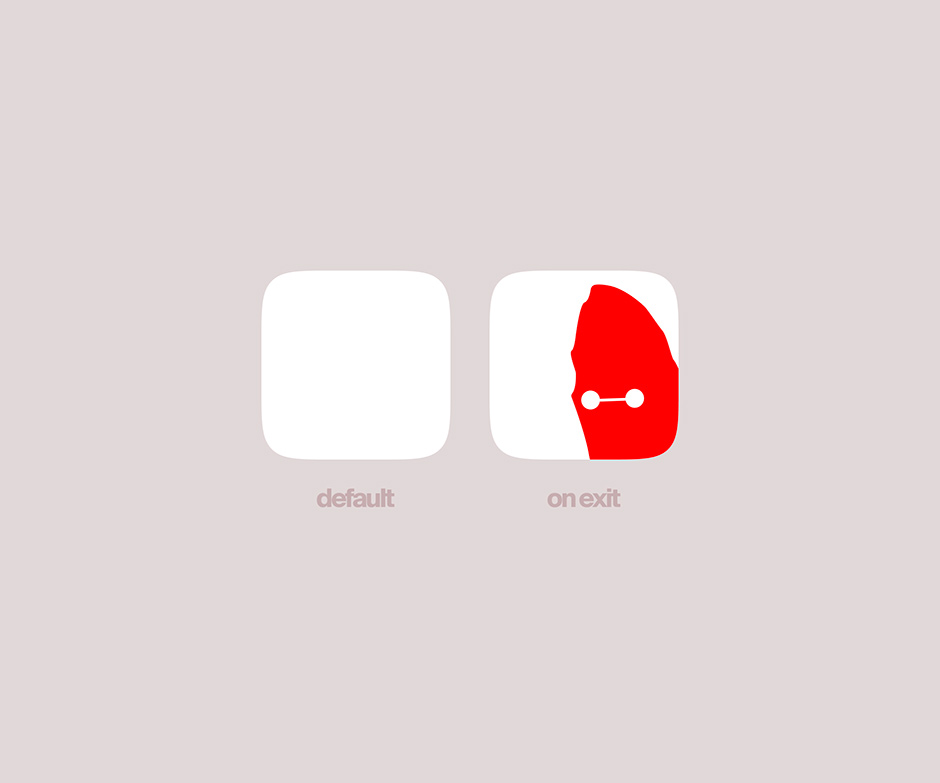
Page titles — update dynamically as you navigate between sections adding an extra layer of interactivity and attention to detail.
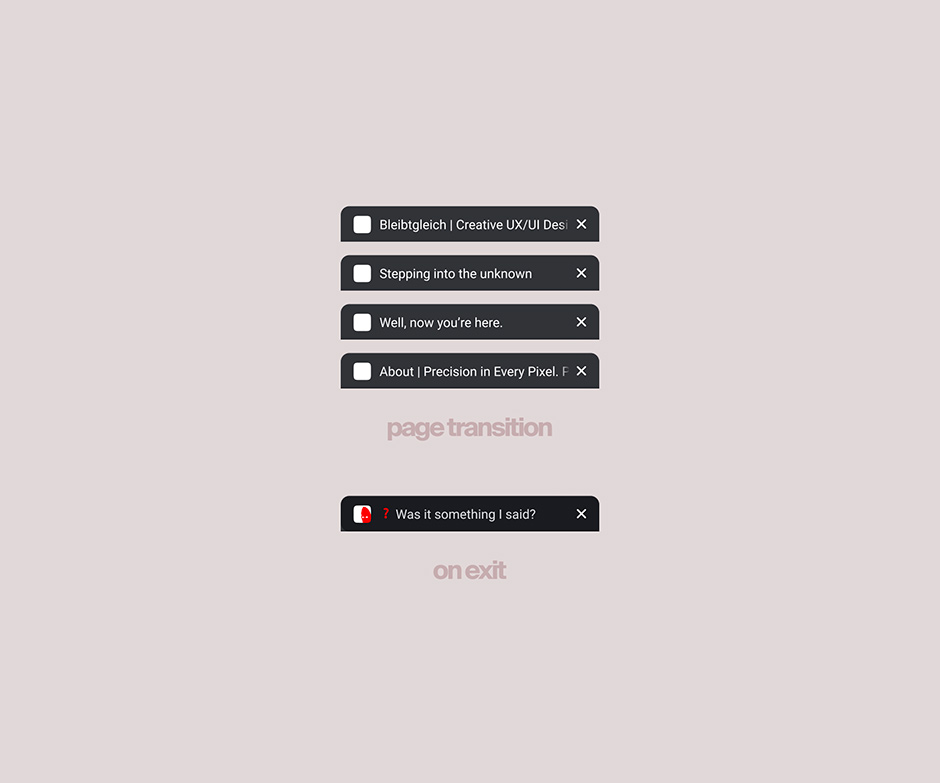
Opengraph — yes, it’s “just” OpenGraph but to me, it feels unique enough. I spent several hours hunting for the right concept, and I think it paid off.
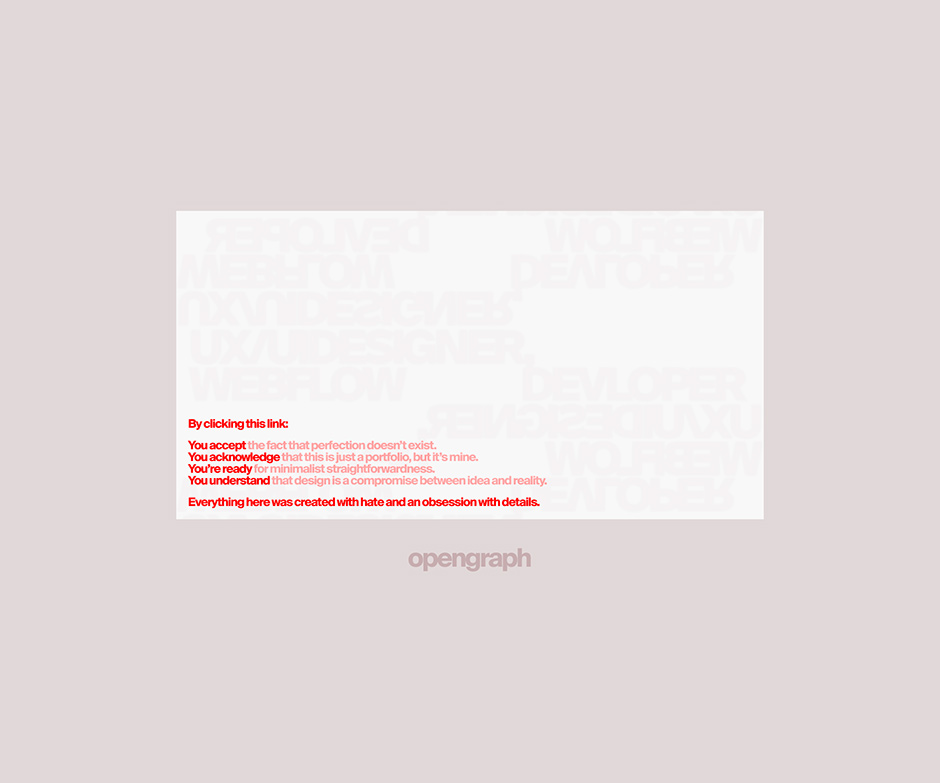
Console Details — Pop open the dev tools and you'll find my thoughts on building the portfolio, along with a live chat. (Yeah, it’s yet another deranged idea that somehow made it into production.)
At one point, I even wanted to hook up ChatGPT via API so you could talk to it right in the console. For now, just type:
“console.log('/msg your edit')”
And surprisingly, it actually worked — someone pointed out a broken LinkedIn link via this feature, and I caught the message (my site is always open in the background). More often, people are just stunned it works at all.
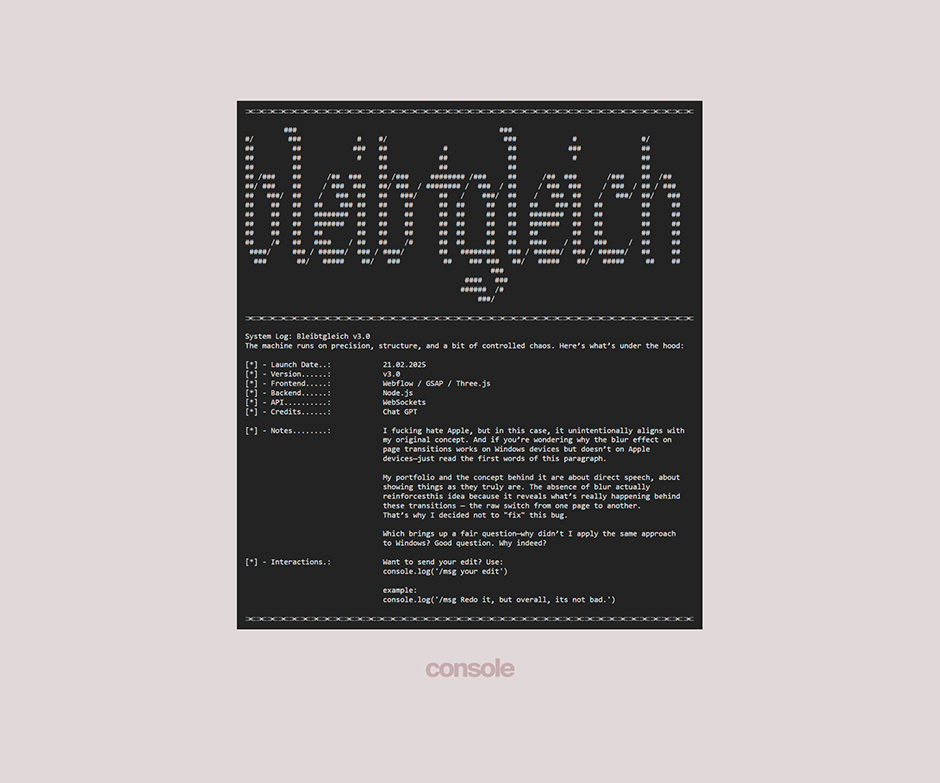
Made with hate, driven by:
- Frontend: Webflow / GSAP / Three.js / WebGL
- Backend: Node.js
- API: WebSockets (Live Cursors / Chat inside Console)
- Deploy: Render
- AI: Grok-3 / Chat GPT (code) / Krea (photo)
About Me
Just designer.
